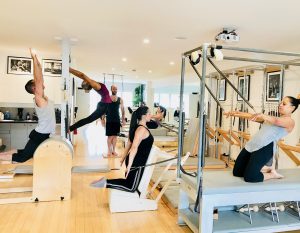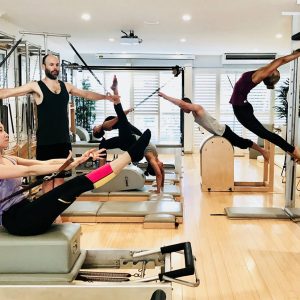Classical Pilates sticks as closely as possible to Joseph Pilate’s original work. This means his original exercises and the order in which they were performed and how the system works as you move from one piece or apparatus to another. The entire work from mat to reformer to chairs, barrels etc are all interconnecting making it a system of full body movement. Classical Pilates teachers focus on the entire body, mind and spirit, and not one specific muscle group making “Classical” Pilates more martial arts oriented.

Another key feature of classical Pilates is that the work is Performed on equipment with the dimensions, spring tension and wheel action as designed by Joseph Pilates. On traditional equipment, (particularly the reformer) the user requires to work the equipment (reformer) by way of resistance work. The spring tension and wheel traction helps the practitioner connect deeply into their “powerhouse”.
Contemporary Pilates infuses Pilates exercise with training principles from Physiotherapists and western medicine and treatments. The contemporary equipment is different in dimensions and spring tension using colour coded springs. The wheel action is smooth and floats without resistance. Contemporary Pilates breaks a lot of the work down adding many more modifications. Contemporary teachers focus of body parts IE: Exercises for the abdominals, exercises for the biceps, triceps lats etc. making contemporary Pilates is more fitness oriented.
Clinical Pilates is used by physiotherapists to treat a wide range of injuries and conditions, ranging from low back pain and chronic pain to hypermobility and chronic fatigue syndrome. The exercises range from the regular physio rehab exercises and some adapted Pilates exercises on the contemporary reformer. Regular Pilates is conducted by a Pilates instructor, whereas Clinical Pilates is prescribed and supervised by a Clinical Pilates trained Physiotherapist or Exercise Physiologist. If the teacher is not a physiotherapist or exercise physiologist then should not claim to teach “Clinical Pilates”.
We all have our preferences and we, at the Authentic Pilates Studio and Authentic Pilates Education International (teacher Training course) prefer and dedicate our teaching to the “Classical” traditional method.
I have taught many Instructors who come from a “Contemporary” Pilates background and are interested or curious about the traditional Classical method.

Most believe that the only difference is that the traditional Pilates relies on a “set order” of repertoire and that the equipment is antiquated and the method is not up with the times! Well that is until they actually experience the method. It doesn’t take long before the true difference in the work is understood and the penny drops!
One such instructor mentioned how much she was enjoying the authentic method more in her body as she practiced each week. “I have been experiencing a rapid change in my body for the better since training in the classical method. It all makes sense now. Even though many of the exercises are the same, the breathing pattern is the opposite and the technique is very different”.
Most instructors feel a huge change in their own body after working in the classical method which is more structured and disciplined in its system. I believe that while many of these instructors continue to teach “contemporary” Pilates they become better teachers having explored and understood more about the Classical method.
So is there a big difference in Pilates methods? It’s a most resounding yes!
Written by the Olga Tamara – Principal Trainer and educator at the Authentic Pilates Studio and Authentic Pilates Education International.